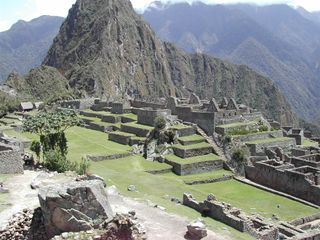Mysticcal Botanica Spiritual Readings, Jamaica Colosseum Mall, Jamaica, Ny
Machu Picchu: Facts & History

Machu Picchu is a 15th-century Inca site located on a ridge between the Huayna Picchu and Machu Picchu mountains in Peru. It sits 7,970 anxiety (2,430 meters) in a higher place sea level on the eastern gradient of the Andes and overlooks the Urubamba River hundreds of anxiety below.
The site'southward excellent preservation, the quality of its architecture, and the breathtaking mountain vista it occupies has made Machu Picchu ane of the most famous archaeological sites in the world today. The site covers 80,000 acres (32,500 hectares). Terraced fields on the edge of the site were one time used for growing crops, likely maize and potatoes.
In 1911, explorer Hiram Bingham Three, a professor at Yale Academy, visited the site and published its being for the first fourth dimension. He institute information technology covered with vegetation, much of which has now been removed. The buildings were made without mortar (typical of the Inca), their granite stones quarried and precisely cutting.
When Bingham discovered the site he was really searching for Vilcabamba, the terminal majuscule of the Inca before their terminal defeat at the hands of the Spanish in 1572.
The explorer found Machu Picchu largely intact, having apparently never been visited past the Spanish conquistadors. In fact, the only reference to the site at all in Castilian documents is a mention of the discussion "Picchu" in a 1568 document, the text implying that it belonged to the Inca emperor.
An emperor's dwelling
Machu Picchu is believed to have been congenital by Pachacuti Inca Yupanqui, the ninth ruler of the Inca, in the mid-1400s. An empire builder, Pachacuti initiated a series of conquests that would eventually run into the Inca grow into a Due south American realm that stretched from Ecuador to Chile.
Many archaeologists believe that Machu Picchu was constructed every bit a royal estate of sorts, the presence of aristocracy residences in the northeast sector of the site backing that idea up. It would have been used by the emperor and his family unit as a temporary respite, the site supporting a small-scale number of year-round caretakers. Other examples of Inca imperial estates are known in Peru.
Interestingly, the abode of the emperor himself appears to exist in the southwest part of the site, away from the other elite residences. A edifice known today as the "Temple of the Sun" is adjacent to information technology.
A staircase running abreast the royal compound leads to a plaza below, and the emperor was afforded a garden, a individual bathroom and even a private toilet surface area — the only private i on site.
Although Machu Picchu has a wall, pocket-sized gateway and dry moat (likely used for collecting rainwater) it doesn't appear to have been set up with military machine purposes in mind, and at that place is no evidence that a battle of any sort was fought at that place.
Temple of the Sun
Machu Picchu has a number of structures that would have enhanced the spiritual significance of the site.
One of them, the "Temple of the Sun," or Torreón, has an elliptical design similar to a sun temple found at the Inca majuscule of Cuzco. Information technology is located near where the Inca emperor is believed to take resided at Machu Picchu.
A rock inside the temple could have served as an altar. During the June solstice the rising sun shines directly into one of the temple'due south windows, and this indicates an alignment betwixt the window, rock and solstice sunday.
Beneath the temple lies a cavern, naturally formed, which the explorer Bingham referred to as a "regal mausoleum," although there's little testify that it was used every bit such. A boulder carved into a stairway lies nearly the cave entrance and the surreptitious chamber likely served a religious function of some form.
Main temple & Intihuatana
A series of religious structures is located on the northwest of the site, bordering the plaza.
One of the buildings, dubbed the "Principal Temple," contains a carved stone altar. When information technology was excavated by Bingham he constitute that it has a layer of white sand, something seen in temples at Cuzco, the Incan capital. [Images: Summit 10 Ancient Capitals]
A building next to the "Principal Temple" is known every bit the "Temple of the Iii Windows" and contains a large amount of broken pottery, ritually smashed it appears.
Just perhaps the biggest puzzle at Machu Picchu is a giant rock, named "the Intihuatana" by Bingham, after other carved stones found in the Incan empire. The rock at Machu Picchu is situated on a raised platform that towers above the plaza. Its purpose is a mystery, with recent research disproving the idea that it acted every bit a sundial. It may take been used for astronomical observations of some form. Information technology may also be connected with the mountains that environs Machu Picchu.
Abandonment of Machu Picchu
Machu Picchu did not survive the collapse of the Inca.
In the 16th century the Spanish appeared in Due south America, plagues afflicting the Inca along with military machine campaigns waged by conquistadors. In 1572, with the fall of the last Incan capital, their line of rulers came to end. Machu Picchu, a majestic manor once visited by slap-up emperors, fell into ruin. Today, the site is on the Un' listing of Globe Heritage sites.
— Owen Jarus, LiveScience Correspondent
Related:
- Image Gallery: Inca Child Mummies
- 'Maiden' Inca Mummy Suffered Lung Infection Earlier Sacrifice
Source: https://www.livescience.com/22869-machu-picchu.html

0 Response to "Mysticcal Botanica Spiritual Readings, Jamaica Colosseum Mall, Jamaica, Ny"
Post a Comment